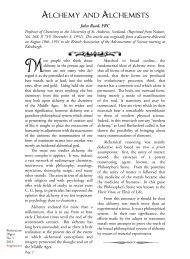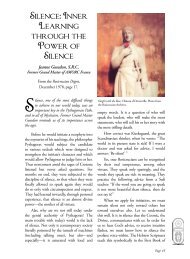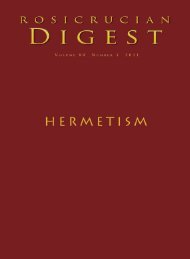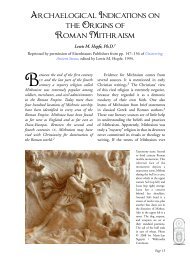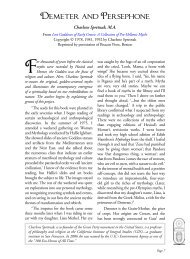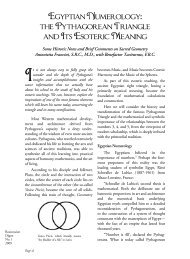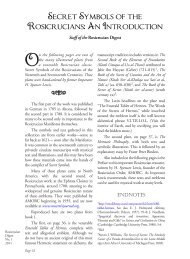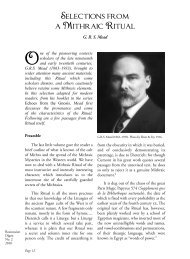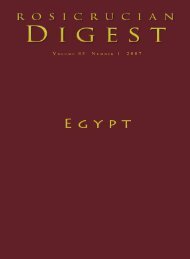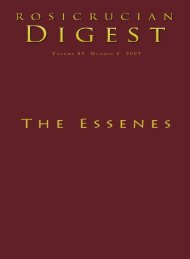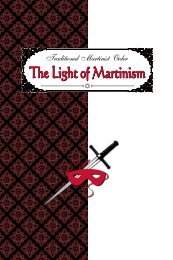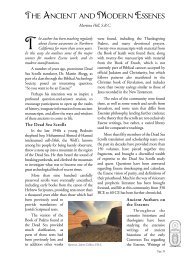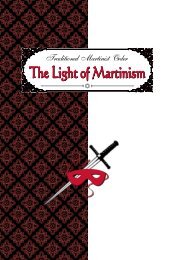Ancient Egypt and Modern Esotericism - Rosicrucian Order
Ancient Egypt and Modern Esotericism - Rosicrucian Order
Ancient Egypt and Modern Esotericism - Rosicrucian Order
Create successful ePaper yourself
Turn your PDF publications into a flip-book with our unique Google optimized e-Paper software.
Jeremy Naydler, Ph.D.<br />
<strong>Rosicrucian</strong><br />
Digest<br />
No. 1<br />
2007<br />
What is it about ancient <strong>Egypt</strong> that<br />
people today find so fascinating?<br />
Jeremy Naydler suggests that what<br />
really draws people to <strong>Egypt</strong> is less the great<br />
monuments <strong>and</strong> works of art than the religious<br />
consciousness that produced them. This religious<br />
consciousness of the ancient <strong>Egypt</strong>ians exposes a<br />
tension in our own culture between the world<br />
view of modern scientific materialism on the one<br />
h<strong>and</strong> <strong>and</strong> a worldview that would connect us<br />
once again with the reality of the spiritual<br />
dimension. Looking back to the ancient<br />
<strong>Egypt</strong>ians, we find that their awareness of the<br />
interior realms of gods, spirits, <strong>and</strong> archetypal<br />
images strikes a surprising chord with our own<br />
deepest longings. This essay is based on a talk<br />
given at the Theosophical Society, London<br />
November 27, 2003.<br />
Jeremy Naydler is the author of two fulllength<br />
studies of ancient <strong>Egypt</strong>ian religious<br />
consciousness: Temple of the Cosmos: The <strong>Ancient</strong><br />
<strong>Egypt</strong>ian Experience of the Sacred (1996) <strong>and</strong><br />
Shamanic Wisdom in the Pyramid Texts: the<br />
Mystical Tradition of <strong>Ancient</strong> <strong>Egypt</strong> (2005).<br />
The Fascination With <strong>Ancient</strong> <strong>Egypt</strong><br />
Today there seems to be an unprecedented<br />
fascination with ancient <strong>Egypt</strong>. We see<br />
evidence of this in the unceasing flow of books<br />
on ancient <strong>Egypt</strong>ian history, culture, <strong>and</strong> art;<br />
in the seemingly inexhaustible TV coverage<br />
that ancient <strong>Egypt</strong> attracts; in the amount of<br />
journals <strong>and</strong> magazines, both scholarly <strong>and</strong><br />
popular, dedicated to widening our<br />
underst<strong>and</strong>ing of the civilization; in the<br />
plethora of societies devoted to studying <strong>and</strong><br />
celebrating it; in the numerous lecture courses<br />
being given in the adult education departments<br />
of our universities; <strong>and</strong>, not least, in the huge<br />
amount of tourists visiting <strong>Egypt</strong> each year. We<br />
might well ask: What lies behind this modern<br />
fascination with ancient <strong>Egypt</strong>?<br />
Page 28<br />
Certainly the <strong>Egypt</strong>ians produced some<br />
monumental buildings <strong>and</strong> stunning works<br />
of art, the gr<strong>and</strong>eur of which makes the<br />
achievements of contemporary civilization<br />
seem paltry by comparison. Were we to<br />
attempt to build a replica of the Great<br />
Pyramid, I doubt that we would succeed.<br />
We are good at mobile phones, washing<br />
machines, freeways <strong>and</strong> airplanes, but I don’t<br />
think we could manage to construct the Great<br />
Pyramid, nor for that matter the temple at<br />
Karnak, nor the tombs of the Valley of the<br />
Kings. It somehow isn’t in us to do the sorts<br />
of things the <strong>Egypt</strong>ians did. We aren’t<br />
motivated that way <strong>and</strong> have neither the<br />
patience nor the skill.<br />
Could it therefore be due as much to our<br />
own deficiencies as to their genius that we feel<br />
attracted to the <strong>Egypt</strong>ians? They did things<br />
that are to us extraordinary, almost<br />
superhumanly extravagant <strong>and</strong> at the same<br />
time deeply mysterious. While there are of<br />
course many things about the <strong>Egypt</strong>ians that<br />
we can relate to, fundamentally they were not<br />
like us.<br />
It seems to me, therefore, that in order to<br />
answer the question as to what lies behind<br />
our fascination with <strong>Egypt</strong>, we need to go<br />
beyond our feelings of awe <strong>and</strong> wonder at the<br />
great monuments <strong>and</strong> works of art, to the less<br />
comfortable feeling of ancient <strong>Egypt</strong>’s utter<br />
strangeness, its otherness. There is something about<br />
<strong>Egypt</strong> that can strike us as positively uncanny.<br />
This is especially the case when we<br />
encounter the religious world of the<br />
<strong>Egypt</strong>ians, populated as it was by a multitude<br />
of gods <strong>and</strong> spirits. Despite the reassuring<br />
images of “daily-life” <strong>Egypt</strong> which are<br />
presented to us in the media <strong>and</strong> in popular<br />
books by <strong>Egypt</strong>ologists, we can often feel that<br />
the ancient <strong>Egypt</strong>ians inhabited a world that
was disturbingly different from our own. In<br />
order to underst<strong>and</strong> that world, <strong>and</strong> to<br />
underst<strong>and</strong> the consciousness of the people<br />
whose world it was, we need to stretch our<br />
imaginations away from everything that is<br />
familiar to us today.<br />
Thutmose III’s Coronation <strong>and</strong> Career<br />
Examined<br />
There was recently (in the autumn of<br />
2003) a particularly lavish drama-documentary<br />
series on ancient <strong>Egypt</strong> on TV. It reconstructed<br />
famous episodes from ancient <strong>Egypt</strong>ian history<br />
with the aid of large casts, including actors who<br />
were supposedly speaking ancient <strong>Egypt</strong>ian<br />
(made to seem all the more authentic by<br />
adding English subtitles).<br />
One of the programs in the series was on<br />
Thutmose III’s campaigns against the Syrians,<br />
his capture of the cities of Megiddo <strong>and</strong><br />
Kadesh, <strong>and</strong> other spectacular military<br />
triumphs. It included an authoritative voiceover<br />
assuring us that the reconstructions were<br />
based on hieroglyphic inscriptions at Karnak.<br />
Needless to say it was all absolutely riveting,<br />
<strong>and</strong> the thous<strong>and</strong>s (or hundreds of<br />
thous<strong>and</strong>s?) of viewers must have felt<br />
themselves to be witnessing virtually the real<br />
thing—<strong>Egypt</strong> as it truly was.<br />
The approach that was taken followed<br />
that which has been taken time <strong>and</strong> again by<br />
<strong>Egypt</strong>ologists, in which Thutmose is<br />
presented as a great warrior <strong>and</strong> empire<br />
builder, somewhat akin to Napoleon,<br />
conceiving of bold <strong>and</strong> daring plans, <strong>and</strong><br />
leading his armies from one victory to<br />
another. 1 The “Napoleonic” image of the<br />
<strong>Egypt</strong>ian king is given credence by the fact<br />
that Thutmose III was indeed a daring <strong>and</strong><br />
shrewd military comm<strong>and</strong>er, who<br />
significantly extended the overseas territories<br />
of <strong>Egypt</strong> <strong>and</strong> added vastly to the wealth <strong>and</strong><br />
power of his country.<br />
But if Thutmose III was a figure who we<br />
feel inclined to compare with Napoleon, then<br />
we must also take care to remember that there<br />
were important differences, not just between<br />
the two personalities, but between the two<br />
cultures in which they lived. In ancient <strong>Egypt</strong><br />
the kingship was not simply a political office,<br />
but was also religious. Even for a warrior king<br />
such as Thutmose III, the relationship to the<br />
invisible world of gods <strong>and</strong> spirits was<br />
fundamental not only to his power <strong>and</strong><br />
success, but also to what it meant to be the<br />
king of <strong>Egypt</strong>.<br />
There is an interesting document that has<br />
come down to us that gives us some insight<br />
into what the kingship of <strong>Egypt</strong> actually<br />
entailed. It is a coronation text of Thutmose<br />
III in which he claims to have had a mystical<br />
encounter with the sungod Amun-Ra that<br />
was, as it were, woven into the coronation<br />
ceremonies. The key features of this<br />
experience were that the king transformed<br />
himself into a falcon, flew up to heaven <strong>and</strong><br />
there had a vision of Amun-Ra, was infused<br />
with the god’s spiritual power <strong>and</strong> assimilated<br />
into himself “the wisdom of the gods.” This is<br />
how the text reads:<br />
“He [Amun-Ra] opened for me the doors<br />
of heaven <strong>and</strong> unfolded the gates of the Akhet<br />
[a place of spiritual transformation]. I rose to<br />
heaven as a divine falcon <strong>and</strong> saw his secret<br />
image in heaven. I worshipped his majesty. . . .<br />
I was infused with all his akh-power [luminous<br />
spiritual power] <strong>and</strong> instructed in the wisdom<br />
of the gods.” 2<br />
This text confronts us with a rather<br />
different image of Thutmose III from the<br />
favored Napoleonic stereotype. The text<br />
itself could go back to 1504 BCE, but it is<br />
similar to much older <strong>Egypt</strong>ian texts (the socalled<br />
Pyramid Texts) found on the inside of<br />
certain Fifth <strong>and</strong> Sixth Dynasty pyramids,<br />
some 800 years earlier. There we find the<br />
same themes of the king of <strong>Egypt</strong><br />
transforming into a falcon <strong>and</strong> flying up to<br />
the sky, where he has a vision of Ra, <strong>and</strong><br />
becomes inwardly infused with the solar<br />
light <strong>and</strong> the wisdom of the gods.<br />
Shamanism <strong>and</strong> <strong>Ancient</strong> <strong>Egypt</strong><br />
Anyone familiar with the literature of<br />
shamanism will recognize a shamanic<br />
undercurrent to this type of mystical<br />
Page 29
<strong>Rosicrucian</strong><br />
Digest<br />
No. 1<br />
2007<br />
experience. One might say that it has a<br />
shamanic “prototype,” for in this literature we<br />
read of initiations in which the shaman<br />
transforms into a bird (often an eagle), flies<br />
up to the sky <strong>and</strong> becomes inwardly illumined<br />
after encountering the Great God, <strong>and</strong> then<br />
returns to his tribe with a newly acquired<br />
spiritual knowledge. 3<br />
Seen in this light, it would appear that<br />
during the coronation rites of the king,<br />
Thutmose III had an experience similar to a<br />
shamanic initiation, <strong>and</strong> was thus in touch<br />
with a dimension of reality that was beyond<br />
anything Napoleon knew. Because it does not<br />
fit our preconceptions of how we would like<br />
to see the great warrior Thutmose, it has been<br />
“screened out” of the mainstream portrayal of<br />
the king. It has indeed been screened out of<br />
the mainstream portrayal of <strong>Egypt</strong>ian culture<br />
as such. Within <strong>Egypt</strong>ology, there is still a<br />
great reluctance to accept that either<br />
mysticism or shamanism existed in ancient<br />
<strong>Egypt</strong>: this is the line taken by most<br />
<strong>Egypt</strong>ologists today, with just one or two<br />
exceptions. So it is hardly surprising that the<br />
media follow suit. 4<br />
Nevertheless, behind the fascination with<br />
ancient <strong>Egypt</strong> today I would suggest that there<br />
is a deep longing to reconnect with precisely<br />
the aspect of ancient <strong>Egypt</strong>ian culture that is<br />
oriented towards spiritual realities. This longing<br />
may be more or less conscious in those people<br />
who feel drawn to ancient <strong>Egypt</strong>, <strong>and</strong> many<br />
may wish to deny any such longing. But as<br />
time goes on <strong>and</strong> it becomes increasingly<br />
difficult to ignore the spiritual foundations of<br />
ancient <strong>Egypt</strong>ian culture, so it may also become<br />
harder to ignore what it is in the culture that<br />
works so mysteriously to draw people to it.<br />
It is as if ancient <strong>Egypt</strong> has a certain<br />
karmic role to play in our times, <strong>and</strong> that<br />
this role is to expose the tension in our<br />
own culture between, on the one h<strong>and</strong>,<br />
our allegiance to the worldview of modern<br />
science, that seeks to account for everything<br />
in the world, past <strong>and</strong> present, in materialistic<br />
terms, <strong>and</strong>, on the other, a longing to escape<br />
Page 30<br />
from the confines of this worldview <strong>and</strong><br />
reconnect with spiritual realities once again.<br />
Put in more general historical terms, this<br />
tension could be seen as living between our<br />
habitual deference to the worldview<br />
inaugurated by the religion of Judaism <strong>and</strong> the<br />
philosophy <strong>and</strong> scientific rationalism of the<br />
Greeks on the one side, <strong>and</strong> an underlying<br />
sense of dissatisfaction with the Judeo-Christian<br />
<strong>and</strong> Greco-Roman foundations of Western<br />
culture on the other.<br />
Undoubtedly the latter have determined<br />
the way in which the consciousness of the West<br />
has developed over the last 2,500 years. But if<br />
we look back to <strong>Egypt</strong> with a sensitivity towards<br />
the spiritual matrix within which the <strong>Egypt</strong>ians<br />
lived, then we may find that the pre-Judaic <strong>and</strong><br />
pre-Greek consciousness of the <strong>Egypt</strong>ians was a<br />
consciousness that strikes a surprising chord<br />
with our own deepest longings.<br />
The Imaginary Versus the Imaginal<br />
The tension that I have referred to in our<br />
own culture <strong>and</strong> sensibility has been noted by<br />
Erik Hornung, one of the most eminent<br />
contemporary <strong>Egypt</strong>ologists who has<br />
specialized in the study of ancient <strong>Egypt</strong>ian<br />
religious literature. He is also one of the<br />
foremost apologists for the non-mystical<br />
interpretation of ancient <strong>Egypt</strong>ian religion. In<br />
his book, The Secret Lore of <strong>Egypt</strong>, he takes<br />
on the question of the relationship between<br />
ancient <strong>Egypt</strong>ian religious life <strong>and</strong> those<br />
Western esoteric traditions that see <strong>Egypt</strong> as<br />
the source of an initiatory wisdom.<br />
To this end, Hornung makes a distinction<br />
between “<strong>Egypt</strong>osophy” <strong>and</strong> <strong>Egypt</strong>ology proper. 5<br />
For Hornung, “<strong>Egypt</strong>osophy” involves projecting<br />
onto ancient <strong>Egypt</strong> an ill-founded wish to see it as<br />
a repository of spiritual knowledge.<br />
<strong>Egypt</strong>ology, by contrast, shows us that<br />
there were no mysteries, no esoteric or<br />
initiatory teachings or practices in ancient<br />
<strong>Egypt</strong>. Western esoteric streams like Alchemy,<br />
Gnosticism, the Hermetic Tradition,<br />
<strong>Rosicrucian</strong>ism, which in their different ways<br />
see their roots as going back to ancient <strong>Egypt</strong>,<br />
are all dealt with by Hornung in a summary
<strong>and</strong> deadpan manner. Chapter by chapter he<br />
sets out to demonstrate that their<br />
underst<strong>and</strong>ing of <strong>Egypt</strong>ian religion has been<br />
tainted by illusory fantasies <strong>and</strong> fails to<br />
correspond with the facts as revealed to us by<br />
modern scholarship.<br />
Hornung’s stance is that <strong>Egypt</strong>ology<br />
studies real <strong>Egypt</strong>, whereas “<strong>Egypt</strong>osophy”<br />
constructs an “imaginary <strong>Egypt</strong>” which bears<br />
only a rather “loose relationship to historical<br />
reality.” 6 Hornung’s approach is very much<br />
that of the modem rationalist for whom what<br />
is real <strong>and</strong> what is imaginary form two sides<br />
of an irreconcilable opposition. It is scarcely<br />
surprising to find that, as a modem rationalist,<br />
Hornung fails to refer to—let alone utilize—<br />
an important distinction that many modern<br />
esotericists, as well as depth psychologists,<br />
make. It is the distinction between what is<br />
merely “imaginary” <strong>and</strong> what is “imaginal.”<br />
The Imaginal Realm<br />
Whereas, what is imaginary is the product<br />
of personal fantasy <strong>and</strong> may therefore be<br />
regarded as subjective, what is imaginal gives<br />
access to a transpersonal content that has an<br />
objective reality, even though it may not<br />
correspond to any historical fact or physical<br />
event. 7 The imaginal realm, or mundus<br />
imaginalis, as it is often termed, has an<br />
existence that is independent of those<br />
individuals who become aware of it. It thus<br />
possesses an ontological status that has a<br />
universal validity that the products of a<br />
person’s private fantasies do not achieve.<br />
Even people with the most slender<br />
knowledge of ancient <strong>Egypt</strong> will be aware<br />
that their world was populated by a very large<br />
number of gods <strong>and</strong> goddesses. These were<br />
essentially invisible beings who were given<br />
imaginative forms which were then<br />
represented in sculpture <strong>and</strong> painting.<br />
If the question arises as to whether the<br />
<strong>Egypt</strong>ians would have regarded these beings<br />
as imaginary or imaginal, we hardly need<br />
pause for an answer. It is quite obvious that<br />
these deities were regarded as both real <strong>and</strong><br />
powerful agencies by the <strong>Egypt</strong>ians, <strong>and</strong> that<br />
it would have seemed to them most unwise<br />
to ignore their objective existence.<br />
Whereas the “<strong>Egypt</strong>osophist” would<br />
concur with the <strong>Egypt</strong>ians in seeing the gods<br />
as real entities, most <strong>Egypt</strong>ologists would be<br />
far less willing to do so. As one specialist put<br />
it, they are to be regarded rather as the<br />
product of “vivid speculation” that is likely to<br />
“disappoint the modern enquiring mind”<br />
than as pointing to any objective reality. 8<br />
We are therefore entitled to ask where the<br />
problem of interpreting ancient <strong>Egypt</strong>ian<br />
religion really lies. Is it with the so-called<br />
“<strong>Egypt</strong>osophists” projecting an imaginary<br />
<strong>Egypt</strong> onto real <strong>Egypt</strong>, or with the<br />
<strong>Egypt</strong>ologists who are unable to recognize<br />
that, for the <strong>Egypt</strong>ians, literal <strong>and</strong> historical<br />
reality was not the only reality: “imaginal”<br />
reality was just as real as hard-<strong>and</strong>-fast<br />
historical “facts.”<br />
Reality is both Visible <strong>and</strong> Invisible<br />
So let us once more return to Thutmose<br />
III <strong>and</strong> his campaign against the Syrians.<br />
Undoubtedly, Thutmose III was a great<br />
warrior. But when we ask, “How did he learn<br />
to become such a great warrior?” the<br />
<strong>Egypt</strong>ian answer would be that he was taught<br />
by the god Seth <strong>and</strong> encouraged by the<br />
goddess Neith.<br />
Figure 1 shows the two deities instructing<br />
the young king. Both were renowned for their<br />
violent disposition—they were both warrior<br />
deities. If Thutmose III was a great warrior,<br />
then it was not, according to the <strong>Egypt</strong>ians,<br />
by virtue of his human qualities as much as<br />
by virtue of his having been infused with<br />
the energy of these two deities.<br />
Fo r t h e <strong>Egypt</strong>ians, there was a world<br />
of archetypal energies or powers that had to<br />
be called upon in order for the king to be a<br />
great warrior. Reality was for them twofold in<br />
this sense: it was both visible <strong>and</strong> invisible.<br />
What we see portrayed in Figure 1 is<br />
Thutmose III with two invisible beings. We<br />
could of course dismiss these beings as<br />
imaginary, but if we were to do so then we<br />
would no longer be seeing the world of the<br />
Page 31
<strong>Rosicrucian</strong><br />
Digest<br />
No. 1<br />
2007<br />
<strong>Egypt</strong>ians as the <strong>Egypt</strong>ians themselves saw<br />
it. For them, these invisible beings were<br />
imaginal in precisely the sense that they were<br />
objectively real.<br />
Let us stay with Thutmose III. A very<br />
different situation is portrayed in Figure 2.<br />
Here there are no invisible deities represented.<br />
We see a relief of Thutmose in the midst of<br />
battle with the Syrians. The king is depicted as<br />
a veritable giant, grabbing the hair of forty-two<br />
paltry Syrians who are shown in three ranks of<br />
fourteen, with their arms outstretched, begging<br />
for mercy. In his right h<strong>and</strong>, the king holds a<br />
mace, with which he is about to dispatch them<br />
with one blow. They are all on their knees,<br />
helpless before the superhuman power of<br />
the king.<br />
One might<br />
be tempted to<br />
say that this<br />
hardly represents<br />
a realistic picture<br />
of the pharaoh<br />
doing battle with<br />
Figure 1. Thutmose III, instructed by<br />
Seth <strong>and</strong> Neith. Neith is represented<br />
abstractly in front of the king,<br />
holding a was sceptre.<br />
Page 32<br />
the Syrians, for,<br />
as we all know,<br />
it would be<br />
impossible for<br />
one man to grab<br />
hold of the hair of forty-two warriors <strong>and</strong> slay<br />
them all with one blow. The image, however,<br />
is evoking an imaginal reality that every<br />
pharaoh embodied, or sought to embody.<br />
This imaginal reality was portrayed from the<br />
very earliest dynastic period, <strong>and</strong> was<br />
represented consistently throughout<br />
E g y p t i a n h i s t o r y a s<br />
something far more than<br />
simply a picture celebrating a<br />
pharaoh’s military victory.<br />
Evocation of Imaginal<br />
Archetypes<br />
To underst<strong>and</strong> such an<br />
image we have to see its<br />
primary purpose as religious:<br />
it was not so much meant to<br />
record a historical event as to<br />
Figure 2. Thutmose III about to slay<br />
forty-two Syrians. From a relief at the<br />
temple of Karnak.<br />
magically evoke an imaginal archetype. While<br />
the image may have been engraved upon<br />
stone after the event, it was—precisely in so<br />
far as it served a religious function—present<br />
at the imaginal level <strong>and</strong> was utilized at that<br />
level to determine the outcome of the<br />
pharaoh’s campaign. 9<br />
The magical efficacy of these images (for<br />
this is just one of a large number, from the<br />
very earliest dynasties, in the same genre) is<br />
due to the fact that they align the pharaoh<br />
with greater than human cosmic forces. What<br />
the pharaoh is shown as enacting is a cosmic<br />
battle between Ma’at (cosmic order, truth,<br />
<strong>and</strong> justice) <strong>and</strong> Isfet (cosmic disorder,<br />
untruth, <strong>and</strong> injustice). It is this archetypal<br />
reality that was made to supervene <strong>and</strong>, as it<br />
were, impress itself upon the historical events<br />
in order to make the pharaoh’s power truly<br />
godlike <strong>and</strong> to assure him of victory.<br />
Figure 3 shows a relief carving in the<br />
same genre, made about three hundred years<br />
after the reign of Thutmose. It portrays the<br />
pharaoh Merenptah almost single-h<strong>and</strong>edly<br />
defeating the invading Sea Peoples.<br />
Surrounding the king is an aura of calm, quiet<br />
confidence, while the invading Sea Peoples<br />
are in total chaos.<br />
Once again, what is portrayed here is<br />
the archetypal reality that each successive<br />
pharaoh actualizes. And in so doing, he<br />
manifests a spiritual energy-field on the<br />
physical plane. The kings of <strong>Egypt</strong> may have<br />
been great warriors, but their prowess did<br />
not rely solely on physical might. They also<br />
operated with magic, <strong>and</strong> it was as much<br />
through magic as through<br />
military skill that they<br />
defeated their enemies. 10<br />
The mythological source<br />
of these images of the king<br />
single-h<strong>and</strong>edly defeating the<br />
enemies of <strong>Egypt</strong> is the defeat<br />
of the cosmic python,<br />
Apophis, every day at midday<br />
<strong>and</strong> every night in the middle<br />
of the night. 11 Apophis is the
form taken by the cosmic forces of chaos,<br />
darkness, <strong>and</strong> disorder that would swallow up<br />
the light- <strong>and</strong> life-giving sungod Ra on the<br />
god’s journey across the skies.<br />
Sometimes Apophis is attacked <strong>and</strong><br />
defeated by Ra’s son Horus, sometimes by<br />
Seth. In Figure 4, it is Seth who st<strong>and</strong>s on the<br />
prow of the sunboat <strong>and</strong> strikes the opposing<br />
serpent. Seth is here the protector of the<br />
principle of light, personified in the falconheaded<br />
sungod, just as he was the instructor<br />
of Thutmose in the arts of war. Thutmose III<br />
was both the defender of Amun-Ra <strong>and</strong> his<br />
protégé <strong>and</strong> representative in his campaigns<br />
against the enemies of <strong>Egypt</strong> in the east.<br />
Figure 3. King Merenptah defeats the Sea Peoples. © 1968<br />
Oxford University Press.<br />
The association of the king of <strong>Egypt</strong> with<br />
the sungod Ra has a further significance. In<br />
the coronation text of Thutmose III, to which<br />
we have already referred, the king was infused<br />
with the luminous spiritual power (the akhpower)<br />
of the sungod in a mystical experience<br />
of union with the mysterious essence of the<br />
lord of light <strong>and</strong> life.<br />
This “solarization” of the king was an<br />
important initiatory event that was undergone<br />
not only at his initial coronation but in subsequent<br />
coronation ceremonies, particularly those of the<br />
Sed festival. The king was<br />
therefore more than just Ra’s<br />
representative on earth, for<br />
he also mystically embodied<br />
the solar principle. One of<br />
the purposes of the Sed<br />
festival was to renew the<br />
inner union of the king with<br />
the solar principle. 12 In a<br />
Figure 5. Amenhotep III is in the role of Ra as he<br />
sails with his wife in a ritual during his Sed festival.<br />
Figure 4. Seth, on the prow of the sunboat, defeats Apophis.<br />
representation of the Sed festival of king<br />
Amenhotep III, the king is clearly fused with the<br />
sungod in a ceremony that involved his sailing in<br />
a replica of the sunboat with his wife, who is<br />
probably in the role of the goddess Hathor<br />
(Figure 5).<br />
The Hidden Realm<br />
On an inner level, this ritual sailing of the<br />
king occurs in the heavens. Just as in the<br />
coronation text of Thutmose III, the king flies<br />
up to the sky in order to worship Ra <strong>and</strong> be<br />
filled with his akh-power, so the context of<br />
the ritual sailing is cosmic. The ancient<br />
<strong>Egypt</strong>ians understood that to become<br />
enlightened one must become aware of that<br />
which is cosmic in one’s own nature. One<br />
must realize that there is something deep<br />
within human nature that is essentially not of<br />
this earth, but is a cosmic principle.<br />
The cosmic being who presided over Ra’s<br />
diurnal voyage across the sky was the<br />
heavenly goddess Nut. It was she who gave<br />
birth to Ra each morning, <strong>and</strong> who received<br />
him into herself again in the evening. Each<br />
evening, when Ra entered her interior realm,<br />
he entered the secret <strong>and</strong> wholly invisible<br />
world that the <strong>Egypt</strong>ians called the Dwat.<br />
The Dwat was conceived as being on the<br />
other side of the stars that we see when we<br />
look up at the night sky. The stars were<br />
imagined as being on the<br />
flesh of the goddess Nut,<br />
<strong>and</strong> the Dwat was in some<br />
sense behind or within<br />
the world of which the<br />
stars demarcated the<br />
outermost boundary. 13<br />
It was not just the<br />
sungod, however, that<br />
Page 33
<strong>Rosicrucian</strong><br />
Digest<br />
No. 1<br />
2007<br />
entered the Dwat at the end of the day. All<br />
creatures were believed to return to the Dwat<br />
at the end of their lives, pass into its dark<br />
interior, <strong>and</strong> were born from it again, just as<br />
the sungod was born from the Dwat each<br />
morning. There was thus a very important<br />
mystical threshold between the outwardly<br />
visible cosmos—the stars on Nut’s body—<br />
<strong>and</strong> what exists invisibly in her interior. It is a<br />
threshold we all come to when we die, when<br />
everything becomes concentrated in a single<br />
point, <strong>and</strong> then disappears from view.<br />
Figure 6 shows the stages of the sungod’s<br />
night-journey through Nut’s body, as he<br />
travels from death to rebirth. Knowledge<br />
of this interior world of the Dwat was<br />
considered by the <strong>Egypt</strong>ians to be the most<br />
important, most profound knowledge,<br />
f o r p e o p l e<br />
living on earth<br />
to acquire.<br />
The Dwat was<br />
not only the<br />
realm of the<br />
dead, but also<br />
the realm of<br />
the gods <strong>and</strong><br />
spirits <strong>and</strong>,<br />
furthermore,<br />
the realm from which all living things<br />
emerge. 14 All life issues from the Dwat. To<br />
know this mysterious interior world was to<br />
become truly wise, because then one knew<br />
both sides of existence—the invisible along<br />
with the visible.<br />
It is interesting that Thutmose III had the<br />
complete text <strong>and</strong> illustrations of the most<br />
comprehensive guide to the Dwat (The Book<br />
of What is in the Underworld) painted on the<br />
inner walls of his tomb in the Valley of the<br />
Kings. As his coronation text reminds us, this<br />
was a king who was “instructed in the wisdom<br />
of the gods.” Unlike Napoleon, Thutmose III<br />
was initiated into a deep spiritual knowledge.<br />
It is not without significance that the name<br />
Thutmose means “born of Thoth,” the god<br />
whom the Greeks identified with Hermes,<br />
<strong>and</strong> from whom one of the most important<br />
Page 34<br />
of the Western esoteric traditions—the<br />
Hermetic Tradition—derives its name.<br />
The Three Tasks<br />
I have tried to show that the <strong>Egypt</strong>ians<br />
lived with an awareness of a dimension of<br />
reality that is best described by the term<br />
“imaginal”—a non-physical yet objective<br />
reality that we become aware of through the<br />
human faculty of imagination. For the<br />
<strong>Egypt</strong>ians, the agencies <strong>and</strong> powers that can<br />
be reached through contact with the imaginal<br />
world are far more potent than anything<br />
merely physical, because through them<br />
physical reality can be transformed.<br />
Thus we have seen how Thutmose III<br />
called upon Seth <strong>and</strong> Neith to infuse him<br />
with a superhuman martial energy that<br />
enabled him to<br />
go to war with<br />
an irresistible<br />
ferocity. In<br />
battle after<br />
battle, he<br />
a n d h i s<br />
accompanying<br />
priests could<br />
also magically<br />
invoke the<br />
imaginal reality of the defeat of the powers<br />
opposed to the sungod <strong>and</strong> Ma’at, both of<br />
whom the pharaoh represented, indeed<br />
embodied, on earth. It was this according to<br />
his own account that brought Thutmose<br />
his victories. 15<br />
Figure 6. The sky-goddess Nut conceals within her body the mysterious inner region<br />
known by the <strong>Egypt</strong>ians as the Dwat.<br />
I have also tried to show that the<br />
<strong>Egypt</strong>ians lived with an underst<strong>and</strong>ing that<br />
we are not just terrestrial beings; we are also<br />
cosmic. As such, our spiritual fulfillment is<br />
only possible in a cosmic setting. This<br />
underst<strong>and</strong>ing is to be found from the earliest<br />
sacred literature (the Pyramid Texts), to the<br />
coronation text of Thutmose III <strong>and</strong> the Book<br />
of the Dead, where, for example, such<br />
mystical episodes as flying up to the sky,<br />
seeing the image of the sungod, boarding the<br />
sun-boat <strong>and</strong>/or becoming inwardly “solarized,”<br />
are all recorded. 16
Finally, I have suggested that the<br />
<strong>Egypt</strong>ians had an orientation towards<br />
the world of the dead (the Dwat) that<br />
saw it as being the source of the most<br />
profound wisdom concerning the<br />
nature of reality. There is a remarkably<br />
rich metaphysical literature concerning<br />
the Dwat, knowledge of which was<br />
evidently regarded as relevant not only<br />
to the dead but also to the living. 17 All<br />
of this was “mainstream” ancient<br />
<strong>Egypt</strong>ian religious consciousness.<br />
The <strong>Egypt</strong>ian Consciousness goes<br />
Underground<br />
At the end of the <strong>Egypt</strong>ian era it went<br />
“underground,” moving from the temple to<br />
the private household, <strong>and</strong> then to the small<br />
group meeting in secret, from whence it<br />
would pass into various esoteric traditions. 18<br />
Thus in the Alchemical tradition, there is a<br />
particular focus on the imaginal realm of<br />
archetypes <strong>and</strong> the path of inner<br />
transformation; in the Hermetic tradition<br />
there is a concentration on the realization of<br />
our cosmic nature; while in Gnosticism we<br />
find a particular emphasis on the invisible<br />
hierarchies of the spirit world. These three<br />
Western esoteric streams could be understood<br />
as each preserving in their different ways the<br />
ancient <strong>Egypt</strong>ian wisdom into the next<br />
cultural era.<br />
Meanwhile the emerging mainstream<br />
culture with its Judeo-Christian <strong>and</strong> Greco-<br />
Roman basis increasingly rejected the old<br />
consciousness. The world became more <strong>and</strong><br />
more impermeable to the divine, archetypal,<br />
<strong>and</strong> imaginal presences. In Judaism the<br />
notion of idolatry—which would have been<br />
incomprehensible to the ancient <strong>Egypt</strong>ians—<br />
came to dominate the religious consciousness,<br />
while the Greeks <strong>and</strong> Romans saw the gods<br />
slowly fade away <strong>and</strong> become less <strong>and</strong> less<br />
easy to communicate with. 19 The new<br />
consciousness meant that people experienced<br />
the world going through a kind of<br />
solidification, so that it was no longer able to<br />
transmit the radiant energies of the divine.<br />
At the same time there emerged an<br />
increasing sense that human beings were<br />
simply terrestrial beings, <strong>and</strong>, consequently,<br />
our happiness was conceived less in cosmic<br />
terms <strong>and</strong> more in terms of satisfying our<br />
physical needs, desires, <strong>and</strong> comforts. The<br />
material world had to be mastered to this<br />
end, <strong>and</strong> this, in time, became the great<br />
project of science <strong>and</strong> technology, which<br />
involved an almost complete forgetfulness of<br />
our cosmic origins.<br />
It also involved a forgetfulness of that part<br />
of human existence that belongs between<br />
death <strong>and</strong> rebirth. There was a growing<br />
identification of the human being solely with<br />
the life that we lead between birth <strong>and</strong> death.<br />
Already, both the Greek <strong>and</strong> Judaic<br />
conceptions of life after death expressed the<br />
conviction that the soul survived as a pale <strong>and</strong><br />
ghostly reflection of its former self. As the<br />
ghost of Achilles says in Homer’s Odyssey, “the<br />
senseless dead” are “mere shadows of men<br />
outworn.” 20 This view, so very different from<br />
that of the <strong>Egypt</strong>ians, culminated in the<br />
modern idea that there simply is no existence<br />
at all after death. <strong>Modern</strong> scientific<br />
materialism is founded upon a total ignorance<br />
of the spirit world.<br />
At the beginning of this essay, I proposed<br />
that ancient <strong>Egypt</strong> exposes a tension in our<br />
own culture, <strong>and</strong> that in so doing we can<br />
see its karmic role today. The reason why it<br />
may be helpful to see <strong>Egypt</strong> in these terms<br />
is because we are now coming to the end of<br />
the Greco-Roman/Judeo-Christian era. It<br />
has achieved its purpose, which was to<br />
make us more individuated, more selfrather<br />
than god-centered in our soul-life,<br />
<strong>and</strong> thus more free.<br />
Becoming Aware again of Inner,<br />
Spiritual Realities<br />
But now there is a need to become aware<br />
again of inner, spiritual realities—but to<br />
become aware of them grounded in our own<br />
sense of self <strong>and</strong> with a clear <strong>and</strong><br />
discriminating intelligence with which we can<br />
once more turn toward them. So I would<br />
Page 35
suggest that it is here that the profound<br />
karmic relationship is working between<br />
ancient <strong>Egypt</strong> <strong>and</strong> the new era that is<br />
beginning to unfold before us.<br />
While our relationship to ancient <strong>Egypt</strong><br />
is certainly based upon our acquiring a deeper<br />
<strong>and</strong> more accurate knowledge of its culture<br />
<strong>and</strong> religion, the relationship is by no means<br />
simply in the direction of the present to the<br />
past. It is also about how the past can support<br />
us in forging our own future by helping us to<br />
reengage with the spiritual dimensions which<br />
were so intrinsic to people’s experience in<br />
times of old. 21<br />
What ancient <strong>Egypt</strong> can do today is to<br />
provide both the impetus <strong>and</strong> the anchorage<br />
for a modern esotericism. By esotericism I<br />
mean knowledge of inner realities. There is<br />
no question of “going back” to ancient <strong>Egypt</strong>.<br />
It is rather the case that by wrestling with<br />
ancient <strong>Egypt</strong>ian sacred texts, we are drawn<br />
down to a deeper level of awareness that we<br />
need to make more conscious. And feeling<br />
this need, we are driven to find our own new<br />
relationship to the spiritual dimension.<br />
As I see it, there are three tasks ahead for<br />
contemporary esotericism. The first is to grow<br />
into a fully felt <strong>and</strong> participative relationship<br />
with the imaginal worlds that st<strong>and</strong> behind<br />
the physical. We need constantly to work at<br />
dissolving the density of the physical <strong>and</strong><br />
literal world. We need to loosen its solidity in<br />
order to see through to the luminous world<br />
of spirits, gods, <strong>and</strong> archetypes that are its<br />
invisible matrix. They are, in a sense, the<br />
“dream” of the world that our modern, all too<br />
wide-awake consciousness has destroyed.<br />
There is a need today to return our waking<br />
consciousness to this dream, by bringing it<br />
once more into a living relationship with the<br />
imaginal dimensions of the world.<br />
Along with this comes the second task,<br />
which is to exp<strong>and</strong> our conception of<br />
ourselves beyond the confines of the earth by<br />
developing a sense that the cosmos that<br />
surrounds us is not just dead matter, but full<br />
of soul. To do this, we need not so much to<br />
work against as to work through the<br />
materialistic conceptions that permeate<br />
modern cosmological thinking. We can<br />
develop once again a feeling for the soulqualities<br />
of the planets <strong>and</strong> constellations, for<br />
the whole world of the stars. And the more<br />
we are able to do this—the more we are able<br />
to connect with the “world soul” or anima<br />
mundi as it used to be called—the more will<br />
we be able to reconnect again with our own<br />
cosmic nature.<br />
I see the third task as being once more to<br />
become aware of the realm of death as the<br />
other half of life, as much a part of our existence<br />
as sleep is a part of our life between birth <strong>and</strong><br />
death. It requires that we see this realm of death<br />
not so much as a place that we go to after we<br />
die, as a realm that we inhabit—or one might<br />
say inhabits us—alongside the world of the<br />
living. The world of death can be understood<br />
as a completely interior world, <strong>and</strong> yet despite<br />
the fact that it has no dimensions, it is not<br />
necessarily inaccessible to consciousness. For its<br />
interiority ultimately coincides with our own.<br />
The more we become aware of the source of<br />
what arises in our own consciousness, the more<br />
do we extend our consciousness towards this<br />
deeply interior realm of death. And in<br />
extending our consciousness towards it, we<br />
extend our consciousness towards that other<br />
half of existence without which we cannot fully<br />
participate in life. 22<br />
<strong>Rosicrucian</strong><br />
Digest<br />
No. 1<br />
2007<br />
Page 36
1 Comparison between Thutmose III <strong>and</strong> Napoleon was first<br />
made by J. H. Breasted, in A History of <strong>Egypt</strong> from the Earliest Times<br />
to the Persian Conquest (London: Hodder <strong>and</strong> Stoughton, 1912),<br />
chap. 16. Since then, it has been reiterated many times. See, for<br />
example, Leonard Cottrell, “The Napoleon of <strong>Ancient</strong> <strong>Egypt</strong>,” in<br />
The Warrior Pharaohs (London: Evans Brothers Ltd, 1968), chap.<br />
6; <strong>and</strong> Peter A. Clayton, Chronicle of the Pharaohs (London:<br />
Thames <strong>and</strong> Hudson, 1994), 109-110.<br />
2 Quoted in Jan Assmann, “‘Death <strong>and</strong> Initiation in the Funerary<br />
Religion of <strong>Ancient</strong> <strong>Egypt</strong>,” in Religion <strong>and</strong> Philosophy in <strong>Ancient</strong><br />
<strong>Egypt</strong>, ed. W. K. Simpson (New Haven: Yale University Press,<br />
1989), 142n41.<br />
3 Mircea Eliade, Shamanism: Archaic Techniques of Ecstasy (London:<br />
Arkana, 1989), chap. 4.<br />
4 For <strong>Egypt</strong>ology’s denial of shamanism in ancient <strong>Egypt</strong>, see<br />
Jeremy Naydler, Shamanic Wisdom in the Pyramid Texts: The<br />
Mystical Tradition of <strong>Ancient</strong> <strong>Egypt</strong> (Rochester, VT: Inner Traditions,<br />
2005), 15-17.<br />
5 Erik Hornung, The Secret Lore of <strong>Egypt</strong>: Its Impact on the West,<br />
trans. David Lorton (Ithaca: Cornell University Press, 2001), 3.<br />
6 Ibid.<br />
7 Henry Corbin, “Mundus Imaginalis, or the Imaginary <strong>and</strong> the<br />
Imaginal,” in Swedenborg <strong>and</strong> Esoteric Islam, trans. Leonard Fox<br />
(West Chester, PA: Swedenborg Foundation, 1995), 1-33.<br />
8 George Hart, A Dictionary of <strong>Egypt</strong>ian Gods <strong>and</strong> Goddesses<br />
(London <strong>and</strong> New York: Routledge <strong>and</strong> Kegan Paul, 1986), x.<br />
9 See Jeremy Naydler, Temple of the Cosmos: the <strong>Ancient</strong> <strong>Egypt</strong>ian<br />
Experience of the Sacred (Rochester, VT: Inner Traditions, 1996),<br />
107-120.<br />
10 As Christian Jacq, <strong>Egypt</strong>ian Magic, trans. Janet M. Davis<br />
(Warminster: Aris <strong>and</strong> Phillips, 1985), 99, explains: “On the field<br />
of battle, the pharaoh’s enemies are not merely human. They are<br />
possessed by a hostile force against which the pharaoh must use<br />
magical weapons. Before any battle, one must proceed to put a<br />
spell on one’s enemies, part of the official techniques of war<br />
practiced by the State. The sacred model for this is supplied by the<br />
rituals which the priests celebrate in the temples for the purpose of<br />
fighting the enemies of the Light.”<br />
11 Ibid., 95-99. For the double defeat of Apophis, see The Book of<br />
the Day <strong>and</strong> The Book of the Night, in A. Piankoff, The Tomb of<br />
Ramesses VI, Bollingen Series 40/1 (New York: Pantheon Books,<br />
1954), 389-407.<br />
12 For a discussion of the solarization of Amenhotep III at his Sed<br />
festival, see W. Raymond Johnson, “Amenhotep III <strong>and</strong> Amarna:<br />
Some New Considerations,” Journal of <strong>Egypt</strong>ian Archaeology 82<br />
(1996), 67ff. See also Naydler, Shamanic Wisdom, 87ff.<br />
13 Naydler, Temple of the Cosmos, 26 <strong>and</strong> 215-217.<br />
14 W. Brede Kristensen, Life Out of Death: Studies in the Religions<br />
of <strong>Egypt</strong> <strong>and</strong> of <strong>Ancient</strong> Greece, trans. H. J. Franken <strong>and</strong> G. R. H.<br />
Wright (Louvain: Peeters Press, 1992), 28, comments: “The world<br />
of death secreted greater powers <strong>and</strong> contained richer possibilities<br />
than the world of finite experience. It was the basis for the whole<br />
existence which we are apt to call worldly life.”<br />
15 The “Annals” at Karnak, recording Thutmose III’s campaigns, are<br />
couched in mythical <strong>and</strong> theistic language. The king is described as<br />
acting in consort with Amun-Ra against the “wretched enemy”—<br />
implicitly identified with the forces of cosmic chaos. The mystical<br />
fusion of king <strong>and</strong> sungod is even more explicit in the so-called<br />
“poetical stela” of Thutmose III found at Karnak. Both texts are<br />
translated in Miriam Lichtheim, <strong>Ancient</strong> <strong>Egypt</strong>ian Literature: A Book of<br />
Readings, (Berkeley: University of California Press, 1976), 2:30-39.<br />
16 The <strong>Ancient</strong> <strong>Egypt</strong>ian Book of the Dead, trans. R. O. Faulkner<br />
(London: British Museum Publications, 1972), chap. 130.<br />
17 Alison Roberts, My Heart, My Mother (Rottingdean: Northgate,<br />
2000), 174-178. It is explicitly stated in The Book of What is in<br />
the Underworld (Amdwat), div.1, that the text is “useful for those<br />
who are on earth” <strong>and</strong> similar indications can be found in The<br />
Book of the Dead, which has been compared by Terence<br />
DuQuesne, A Coptic Initiatory Invocation (Thame: Darengo,<br />
1991), 52n112, with the Tibetan Bardo Thodol—a text clearly<br />
intended for spiritual practice.<br />
18 Garth Fowden, The <strong>Egypt</strong>ian Hermes (Princeton: Princeton<br />
University Press, 1986), chap.7; <strong>and</strong> David Frankfurter, Religion in<br />
Roman <strong>Egypt</strong> (Princeton: Princeton University Press, 1998), chaps.<br />
5 <strong>and</strong> 6.<br />
19 See, for example, Plutarch’s essay, “‘The Decline of the Oracles,”<br />
in Plutarch, Moral Essays, trans. Rex Warner (Harmondsworth:<br />
Penguin Books, 1971), 31-96.<br />
20 Homer, The Odyssey, trans. Ennis Rees (Indianapolis: Bobbs-<br />
Merrill, 1977), 188.<br />
21 In a series of lectures on the relationship of <strong>Egypt</strong>ian mythology<br />
to modern civilization, Rudolf Steiner, Universe, Earth <strong>and</strong> Man,<br />
trans. Harry Collison (London: Rudolf Steiner Publishing Co.,<br />
1941), 250ff., makes the following statement: “What we call<br />
‘future’ must always be rooted in the past; knowledge has no value<br />
if not changed into motive power for the future. The purpose for<br />
the future must be in accordance with the knowledge of the past,<br />
but this knowledge is of little value unless changed into propelling<br />
force for the future.”<br />
22 This text, “<strong>Ancient</strong> <strong>Egypt</strong> <strong>and</strong> <strong>Modern</strong> <strong>Esotericism</strong>” © Jeremy<br />
Naydler, 2006 is reprinted with permission of the author. All<br />
Rights Reserved.<br />
Illustration Sources<br />
1. Thutmose III, instructed by Seth <strong>and</strong> Neith. Drawing from a<br />
relief carving at the temple of Amun, Karnak (18th Dynasty) from<br />
Adolf Erman, Life in <strong>Ancient</strong> <strong>Egypt</strong> (New York: Dover, 1971), 282.<br />
2. Thutmose III about to slay forty-two Syrians. From the rear of<br />
the seventh pylon, Temple of Arnun, Karnak.<br />
3. King Merenptah defeats the Sea Peoples. Drawing from a relief<br />
carving from A. Gardiner, <strong>Egypt</strong> of the Pharaohs (Oxford: Oxford<br />
University Press, 1966), 286, fig. 11. Reprinted with permission.<br />
4. Seth, on the prow of the sunboat, defeats Apophis. From the<br />
Papyrus of Her Uben (B). A. Piankoff, Mythological Papyri (New York:<br />
Pantheon Books, 1957), 75, fig. 54. Reprinted with permission.<br />
5. Amenhotep III is in the role of Ra. From the Tomb of Kheruef<br />
reproduced in J. Naydler, Shamanic Wisdom in the Pyramid Texts<br />
(Rochester Vt.: Inner Traditions, 2005), 206. Reprinted with permission.<br />
6. The sky-goddess Nut conceals within her body the mysterious<br />
inner region. From the abbreviated version of the Book of Night<br />
on the ceiling of the sarcophagus chamber of the tomb of Ramesses<br />
IX, Valley of the Kings, from Erik Hornung, The Valley of the<br />
Kings, trans. David Warburton (New York: Timken, 1990), 79.<br />
Every effort has been made to find the copyright owner.<br />
Page 37




